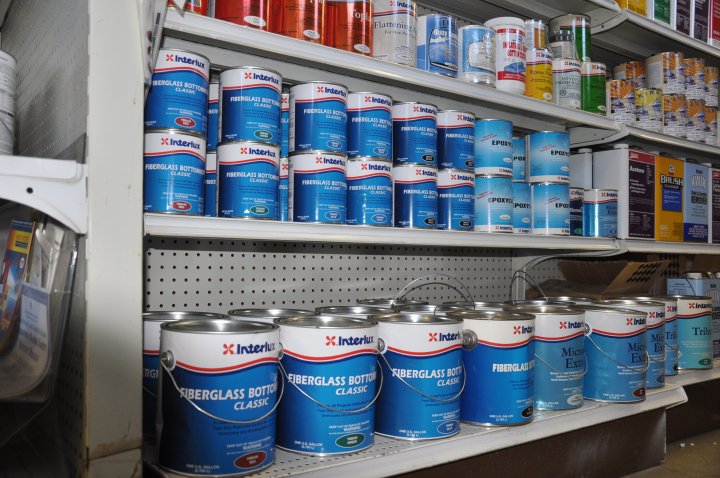Best Eco-friendly Antifouling Bottom Paint
Antifouling paints are essential for protecting your boat and keeping away marine organisms that attach to the hull. There are different types of antifouling paints and each one serves a different purpose. But, their main characteristic is that they prevent biofouling or biological fouling. When applying bottom paint you reduce friction, improve fuel efficiency and speed as well as protect metals, fiberglass, and aluminum that are exposed to water. But, what’s the main downside of bottom paints? Most bottom paints contain harmful and toxic substances that pollute the aquatic environment. We live in an era in which the task of protecting our planet is of high importance. So, fortunately, the evolution of bottom paints has given us the option to choose among different varieties of eco-friendly bottom paints. Now, keep reading if you want to learn some more details on this matter and find out which are the best eco-friendly bottom paints!
General Info about Antifouling Paints
Antifouling paints are applied to the boat’s hull to prevent marine growth in the underwater area. The organisms attached to the hull can seriously affect the boat’s performance and durability. These marine organisms are algae, weeds, barnacles, slime, mussels, worms, etc. Furthermore, bottom paints protect the hull from corrosion and improve the vessel’s capabilities. Generally, bottom paints have to adhere to the hull so they have to be sticky, but, at the same time, slippery in order to prevent marine growth.
Basic paintings include ablative paints, vinyl, epoxy-based hard paints, and copolymer or self-polishing paints. Hard paints contain high levels of biocides which are released slowly. On the other hand, ablative paints contain lower levels of toxins which are released at a more steady rate. Both types of paints have negative impacts on the aquatic environment. Bottom paints have to be renewed every now and then but this will mostly depend on the type of paint, usage of your boat, and the hull’s material.
What is Biofouling?
Biofouling refers to the accumulation of microorganisms, plants, and animals attached to the hull. When there’s fouling on the underwater area of your boat then this will result in less speed, increased fuel consumption, and a higher frequency of dry-dockings. Furthermore, you’ll need to perform extensive maintenance to your hull resulting in loss of both time and money. Biofouling includes macrofouling and microfouling. Macrofouling refers to the marine organisms that get to your hull in order to create their own fouling community. Microfouling refers to the creation of biofilm produced by microorganisms as well as their adhesion to your boat’s surface. Microfouling is the first step regarding the growth of biofouling on hard substrates that are submerged in the water. And, macrofouling develops the growth of several marine organisms such as protozoa, diatoms, and other unicellular or multicellular organisms that tend to colonize rapidly on the boat’s surface.
Negative Impacts of Antifouling Paints
In general, most anti-fouling bottom paints are based on a slow release of toxins, or otherwise the self-polishing coatings. The antifouling performance of these paints is quite effective but the amount of toxin released per boat causes serious damages to the aquatic environment. Therefore, this impact on nature is quite detrimental. Over time, there were several restrictions and bans regarding some substances used in antifouling paints. Copper-based paints cause the most serious impacts on the marine environment but all types of bottom paints cause, more or less, the same impacts. Let’s see the negative impacts on the marine environment:
- The amount of toxins released in the water is generally small and attacks mostly on small marine organisms. And, what’s the problem with that? Well, fish that get fed from microorganisms, such as larvae and plankton, will eventually become infected. And then the toxins, which are basically heavy metals and remain in their bodies, will reach the food chain which leads directly to us, humans!
- Another important negative impact is the poisoning of species that aren’t harmful to your boat. Not all organisms damage your boat but they’ll get poisoned either way. They’ll ingest the toxins which go directly to their nervous system and eventually will die from convulsion.
- Most substances and toxins in bottom paints have an extremely long lifespan. This means that they remain in the bottom of rivers and lakes for many centuries. In case of an unexpected natural phenomenon, these toxins will be released into the water and will once again be activated.
- Let’s not omit to refer to negative impacts on human beings! Toxins have considerably harmful effects on humans as well. They penetrate the human skin, attack the nerve ends, and might cause serious infections and disturbances, depending on each individual’s tolerance levels.
- Last but definitely not least, is the pollution of the water. As responsible sailors and human beings, we should reconsider before taking any action or purchasing to the detriment of the environment. Keep in mind that only 2.75% of the water on Earth is fresh water and about 2% is frozen in glaciers. Although the population of Earth is constantly increasing the water supply is not. And for this reason, we need to reconsider our consumption and alternatives so as to minimize water pollution.
Eco-Friendly Alternative Bottom Paints
Nowadays, there are different eco-friendly alternatives to antifouling paints. These are hydrophilic coatings, enzyme-based systems, non-stick coatings, copper-free coatings, and a new fouling release system. Let’s see in detail these eco-friendly alternatives:
- Hydrophilic antifouling paints prevent the adherence of marine organisms to the hull. The formulation of this anti-fouling paint consists of hydrogel technology along with a network of advanced polymer chains. This system absorbs high amounts of water in order to create a water-like boundary layer. Then, the water layer leads the fouling organisms to believe that the hull is a liquid and solid surface. As a result, this process minimizes microorganisms and bacterial adhesion to the hull.
- Enzyme-based antifouling paints are a bio-based and non-accumulating eco-friendly alternative. The paint is based on a hydrogen peroxide-producing system that contains starch, and hexose oxidase, among others, in order to successfully incorporate them into a marine coating. The activity and stability of these substances and enzymes in seawater were successful in creating alternative coating formulations. Along with a biomimetic encapsulation procedure and a silica co-precipitation, there were significant improvements in terms of stability and performance of the antifouling system in the marine environment.
- Non-stick coatings are based on a system that prevents the adhesion of fouling organisms. This is due to the creation of a low-friction and smooth surface on which organisms have difficulty in adhering. Even though the coatings do not significantly prevent fouling they provide self-cleaning ability when sailing at a certain speed; minimum at 15 knots at a minimum 75% of the time.
- Copper-free paints are very effective but they require a high concentration of substances in order to work well against all types of marine fouling. These paints use copper thiocyanate in place of copper metals. Moreover, they usually contain additional biocides like zinc pyrithione or organic algaecides. These biocides can effectively deal with slime and weed growth.
- A new fouling release system called “eSHaRK” is an eco-friendly boat hull system with fuel-saving properties. This innovative project introduces a fouling-protection technology that maintains the fouling protection standards and is significantly superior to traditional paints. This system differentiates from existing paint solutions in terms of ease of application, eco-friendliness, and fuel savings that lead to the reduction of greenhouse gas emissions.
Best Eco-Friendly Bottom Paints
Pettit Ultima Eco
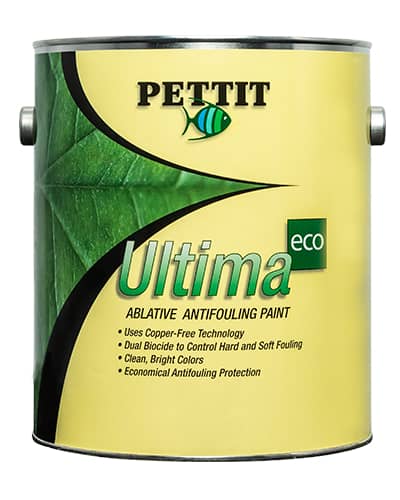
Pettit Ultima Eco is a copper-free anti fouling paint that contains a dual biocide able to control both hard and soft fouling on different surfaces. Substances like organic ECONEA biocide and a powerful slime fighting agent effectively prevent marine growth. The self-polishing ablative technology eliminates the need for sanding and paint build-up. Check the product on Amazon right here.
Pettit Paint Hydrocoat ECO
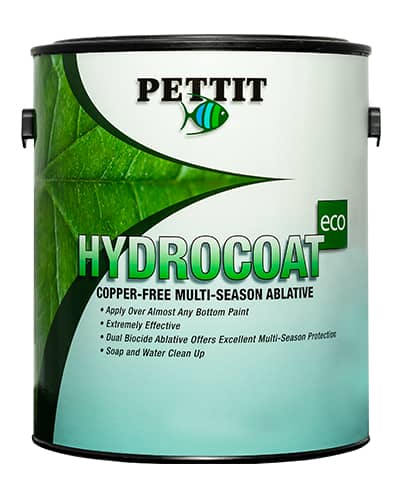
Another great water-based ablative bottom paint that wears away with use, reveals a new surface, and then eliminates paint buildup. This paint contains high amounts of ECONEA resulting in the hulls and marine environment protection. This formula offers multiple seasons of protection as it contains a powerful slime-fighting agent. Also, depending on the environment, the paint will last for multiple seasons. Lastly, the copper-free formula is great for different substrates like steel, GRP, and aluminum. Check it out on Amazon.
TotalBoat Krypton Copper-Free Boat Paint
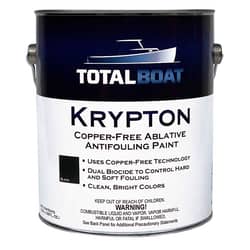
This environmentally friendly ablative paint ensures effectiveness and ease of use. The powerful formula contains a sufficient concentration of ECONEA combined with slime-fighting zinc. This paint can be applied on aluminum, fiberglass, steel, or wood sailboats in both fresh and saltwater environments. Moreover, you can apply it to different underwater metals such as outdrives and trim tabs. It comes out in five colors and is available in gallons or quarts. Check it out right here.
Interlux Aqua-One Performance Ablative
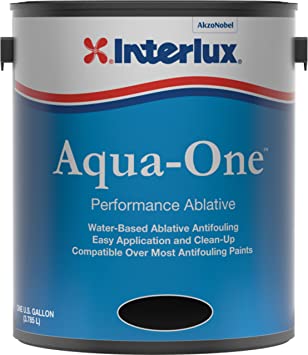
This water-based antifouling paint offers solid protection against all types of marine fouling. Aqua-One paint wears away with use, reduces paint build-up and the need for sanding between applications. It’s odorless and is easy to clean-up with soap and water. Moreover, it can be applied on powerboats and on fiberglass, wood, and metal hulls. Check out this environmentally-friendly and water-based formula right here on Amazon.
Seahawk Paint – Colorkote
This antifouling coating incorporates a triple biocide and low-leaching chemistry that effectively fights against marine growth. It has a multi-season performance and can be applied to different hull types. Check out its different colors right here.
Ecominder Antifouling Bottom Paint
This environmentally friendly and highly effective copper-free paint is a newcomer product in today’s market. The zero VOC, water-based formula is compatible with different surfaces such as aluminum, fiberglass, and wood. The paint contains hydrogen peroxide generated from the sun as well as a booster biocide, Zinc omadine. Also, it can be applied in cool temperatures, is compatible with different boat paint systems, and is available in different colors to choose from.
Sea Hawk – Mission Bay
This solvent-free (CSF) paint uses a nano-based technology copolymer and a biocide release mechanism. This nano-based technology copolymer releases an active copper-free biocide when exposed to the sunlight. Therefore, this dissipates in a short period of time without bioaccumulation into the environment. Lastly, the paint prevents regular coating build-up and ensures excellence and less environmental damage. Check it out right here.
Interlux Micron CF Antifouling Paint
Micron CF is a multi-season and copper-free antifouling paint. Its formula contains a Biolux slime-blocking technology and ECONEA to prevent zebra mussels and barnacles from attaching to the hull. The paint can be applied on both powerboats or sailboats, including aluminum hulls. As a polishing antifouling, Micron CF wears away, reduces friction, paint build-up, and improves fuel efficiency. You can check the Micron CF by Interlux right here.
The Bottom Line
Nowadays, the bottom paint industry is searching for eco-friendly alternatives and tries to minimize the use of harmful biocides. Toxins and chemical compounds in antifouling paints cause serious irreversible damages to the marine environment and can also be harmful to our health. So, several strategies and systems have been developed that use ultrasonic waves, enzymes, silicone liquids, etc. Many companies invest a lot in order to research and expand the efficiency of antifouling eco-friendly coatings. Hopefully, these intentions will increase the market’s demand for eco-friendly bottom paints. I hope that this article was helpful to your research on eco-friendly bottom paints and shed some light on bottom paint alternatives. And, remember that when we adopt and support environmentally safe and effective antifouling techniques we protect our oceans, our health, and our boat! So, always make your best to go green!
